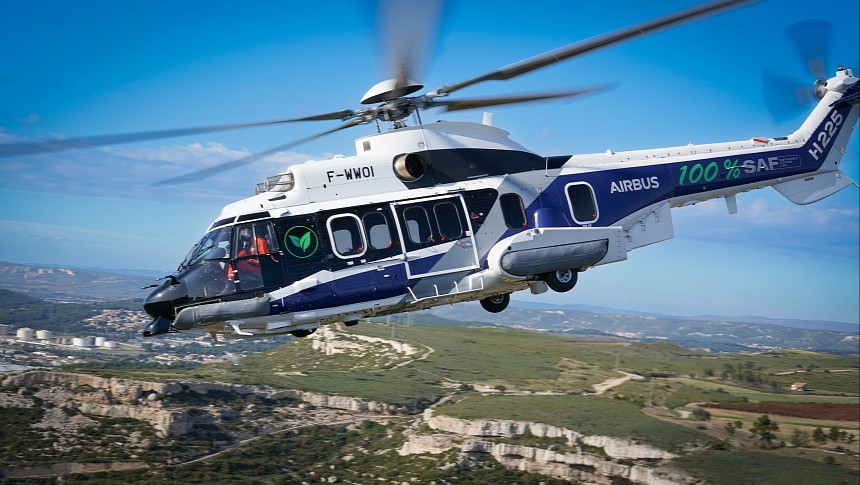Two years ago, an Airbus H225 became the brand's first helicopter to fly with a SAF (sustainable aviation fuel) mix in its engine. For this year's Tour de France operations, the Airbus H125 rotorcraft operated by HBG will also run on this alternative fuel. It's a big change in a relatively short period of time, confirming that the aviation giant is on track when it comes to the bold goal of certifying its entire helicopter range to run on SAF.
People all over the world are able to enjoy the popular Tour de France thanks to the incredible images broadcasted with the help of helicopters flying at low levels. The efforts behind this are tremendous, and they include complex infrastructure setups. Helicopters are used both for capturing and transmitting images and for VIP transportation throughout the event. To make this work, organizers use several temporary helipads for refueling.
Starting last year, they also introduced a biofuel-related requirement. During last year's event, HBG (the helicopter operator) used SAF for a third of the operations. In 2023, this will be increased to 50% for the ASO (the Tour's organizer) stages and 30% for Euromedia (France Televisions). It means that biofuel will power half of the VIP transportation and a smaller percentage of the low-level flights for broadcasting.
Another innovation at the 2023 Tour de France is increased SAF availability. Compared to the previous year, when the operator had to work with a single storage and delivery point for biofuel, this year's event benefits from multiple supply stations set up at several airports. The Annemasse airport will even get support from a dedicated truck for refueling.
At the moment, SAF is confirmed to reduce up to 80% of emissions levels throughout its lifecycle, and mainstream aircraft are certified to operate with a 50% SAF blend. Airbus Helicopters plans to certify its entire range for the use of 100% SAF by the end of this decade. This will equal zero-emission rotorcraft operations without sacrificing performance. Until then, the main benefit of this green jet fuel is that it works with airplanes and helicopters without the need for any structural or engine modifications.
Airbus was one of the pioneers of testing alternative fuel for rotorcraft. In early 2021, it kicked off a test campaign with an H145 used for search-and-rescue operations in Germany. Safran, TotalEnergies, and the ADAC Foundation were the main partners in this trailblazing project. At the time, the H145 flew on a 40% SAF blend. Later that year, the aviation giant completed another major flight using unblended SAF to power an H225.
Airbus was also linked to the first SAF-powered helicopter flights in Japan (in 2022) and in China earlier this year.
Starting last year, they also introduced a biofuel-related requirement. During last year's event, HBG (the helicopter operator) used SAF for a third of the operations. In 2023, this will be increased to 50% for the ASO (the Tour's organizer) stages and 30% for Euromedia (France Televisions). It means that biofuel will power half of the VIP transportation and a smaller percentage of the low-level flights for broadcasting.
Another innovation at the 2023 Tour de France is increased SAF availability. Compared to the previous year, when the operator had to work with a single storage and delivery point for biofuel, this year's event benefits from multiple supply stations set up at several airports. The Annemasse airport will even get support from a dedicated truck for refueling.
At the moment, SAF is confirmed to reduce up to 80% of emissions levels throughout its lifecycle, and mainstream aircraft are certified to operate with a 50% SAF blend. Airbus Helicopters plans to certify its entire range for the use of 100% SAF by the end of this decade. This will equal zero-emission rotorcraft operations without sacrificing performance. Until then, the main benefit of this green jet fuel is that it works with airplanes and helicopters without the need for any structural or engine modifications.
Airbus was one of the pioneers of testing alternative fuel for rotorcraft. In early 2021, it kicked off a test campaign with an H145 used for search-and-rescue operations in Germany. Safran, TotalEnergies, and the ADAC Foundation were the main partners in this trailblazing project. At the time, the H145 flew on a 40% SAF blend. Later that year, the aviation giant completed another major flight using unblended SAF to power an H225.
Airbus was also linked to the first SAF-powered helicopter flights in Japan (in 2022) and in China earlier this year.







